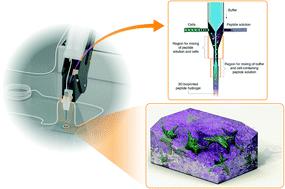当前位置:
X-MOL 学术
›
J. Mater. Chem. B
›
论文详情
Our official English website, www.x-mol.net, welcomes your
feedback! (Note: you will need to create a separate account there.)
Self-assembling tetrameric peptides allow in situ 3D bioprinting under physiological conditions
Journal of Materials Chemistry B ( IF 6.1 ) Pub Date : 2020-12-22 , DOI: 10.1039/d0tb02424d Sakandar Rauf 1, 2, 3, 4, 5 , Hepi H. Susapto 1, 2, 3, 4, 5 , Kowther Kahin 1, 2, 3, 4, 5 , Salwa Alshehri 1, 2, 3, 4, 5 , Sherin Abdelrahman 1, 2, 3, 4, 5 , Jordy Homing Lam 3, 4, 5, 6, 7 , Sultan Asad 1, 2, 3, 4, 5 , Sandip Jadhav 1, 2, 3, 4, 5 , Dhakshinamoorthy Sundaramurthi 1, 2, 3, 4, 5 , Xin Gao 3, 4, 5, 6, 7 , Charlotte A. E. Hauser 1, 2, 3, 4, 5
Journal of Materials Chemistry B ( IF 6.1 ) Pub Date : 2020-12-22 , DOI: 10.1039/d0tb02424d Sakandar Rauf 1, 2, 3, 4, 5 , Hepi H. Susapto 1, 2, 3, 4, 5 , Kowther Kahin 1, 2, 3, 4, 5 , Salwa Alshehri 1, 2, 3, 4, 5 , Sherin Abdelrahman 1, 2, 3, 4, 5 , Jordy Homing Lam 3, 4, 5, 6, 7 , Sultan Asad 1, 2, 3, 4, 5 , Sandip Jadhav 1, 2, 3, 4, 5 , Dhakshinamoorthy Sundaramurthi 1, 2, 3, 4, 5 , Xin Gao 3, 4, 5, 6, 7 , Charlotte A. E. Hauser 1, 2, 3, 4, 5
Affiliation

|
We have developed an in situ bioprinting method that allows the printing of cells under true physiological conditions by applying self-assembling ultrashort peptides as bioinks. This method avoids cell stressing methods, such as UV-treatment, chemical crosslinking and viscous bioink printing methods. We further demonstrate that different nanomaterials can easily be synthesized or incorporated in the 3D bioprinted peptide scaffolds which opens up the possibility of functionalized 3D scaffolds.
中文翻译:

自组装四聚体肽允许在生理条件下进行原位3D生物打印
我们已经开发了一种原位生物打印方法,该方法通过应用自组装超短肽作为生物墨水,可以在真实的生理条件下打印细胞。此方法避免了对细胞施加压力的方法,例如UV处理,化学交联和粘性生物墨水印刷方法。我们进一步证明,不同的纳米材料可以轻松地合成或并入3D生物打印的肽支架中,这为功能化3D支架打开了可能性。
更新日期:2021-01-06
中文翻译:

自组装四聚体肽允许在生理条件下进行原位3D生物打印
我们已经开发了一种原位生物打印方法,该方法通过应用自组装超短肽作为生物墨水,可以在真实的生理条件下打印细胞。此方法避免了对细胞施加压力的方法,例如UV处理,化学交联和粘性生物墨水印刷方法。我们进一步证明,不同的纳米材料可以轻松地合成或并入3D生物打印的肽支架中,这为功能化3D支架打开了可能性。











































 京公网安备 11010802027423号
京公网安备 11010802027423号